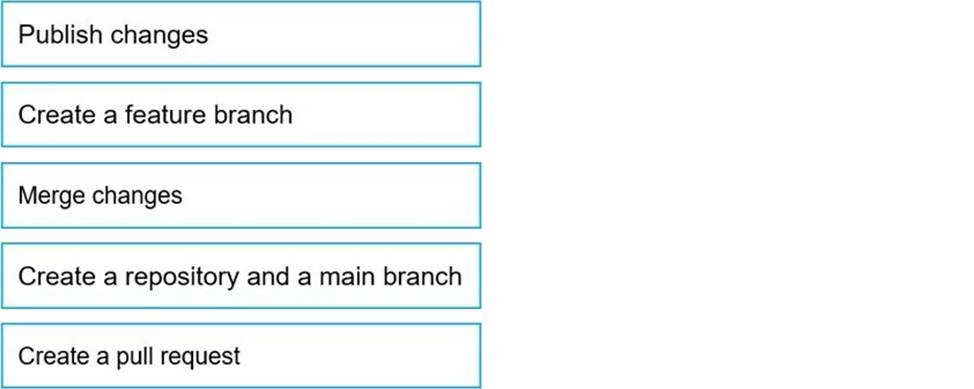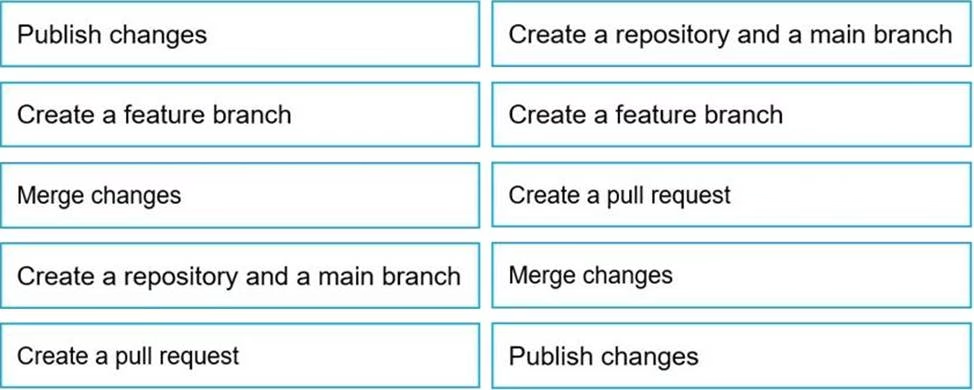In which order should you perform the actions?
DRAG DROP
You need to implement versioned changes to the integration pipelines. The solution must meet the data integration requirements.
In which order should you perform the actions? To answer, move all actions from the list of actions to the answer area and arrange them in the correct order.

Answer:

Explanation:
Scenario: Identify a process to ensure that changes to the ingestion and transformation activities can be version-controlled and developed independently by multiple data engineers.
Step 1: Create a repository and a main branch
You need a Git repository in Azure Pipelines, TFS, or GitHub with your app.
Step 2: Create a feature branch
Step 3: Create a pull request
Step 4: Merge changes
Merge feature branches into the main branch using pull requests.
Step 5: Publish changes
Reference: https://docs.microsoft.com/en-us/azure/devops/pipelines/repos/pipeline-options-for-git
1 1. You need to design a data retention solution for the Twitter feed data records. The solution must meet the customer sentiment analytics requirements.
Which Azure Storage functionality should you include in the solution?
A . change feed
B . soft delete
C . time-based retention
D . lifecycle management
Answer: B
Explanation:
Scenario: Purge Twitter feed data records that are older than two years.
Data sets have unique lifecycles. Early in the lifecycle, people access some data often. But the need for access often drops drastically as the data ages. Some data remains idle in the cloud and is rarely accessed once stored. Some data sets expire days or months after creation, while other data sets are actively read and modified throughout their lifetimes. Azure Storage lifecycle management offers a rule-based policy that you can use to transition blob data to the appropriate access tiers or to expire data at the end of the data lifecycle.
Reference: https://docs.microsoft.com/en-us/azure/storage/blobs/lifecycle-management-overview
Topic 2, Litware, inc.
Case study
Overview
This is a case study. Case studies are not timed separately. You can use as much exam time as you would like to complete each case. However, there may be additional case studies and sections on this exam. You must manage your time to ensure that you are able to complete all questions included on this exam in the time provided.
To answer the questions included in a case study, you will need to reference information that is provided in the case study. Case studies might contain exhibits and other resources that provide more information about the scenario that is described in the case study. Each question is independent of the other questions in this case study.
At the end of this case study, a review screen will appear. This screen allows you to review your answers and to make changes before you move to the next section of the exam. After you begin a new section, you cannot return to this section.
To start the case study
To display the first question in this case study, click the Next button. Use the buttons in the left pane to explore the content of the case study before you answer the questions. Clicking these buttons displays information such as business requirements, existing environment, and problem statements. If the case study has an All Information tab, note that the information displayed is identical to the information displayed on the subsequent tabs. When you are ready to answer a question, click the Question button to return to the question.
Overview
Litware, Inc. owns and operates 300 convenience stores across the US. The company sells a variety of packaged foods and drinks, as well as a variety of prepared foods, such as sandwiches and pizzas.
Litware has a loyalty club whereby members can get daily discounts on specific items by providing their membership number at checkout.
Litware employs business analysts who prefer to analyze data by using Microsoft Power BI, and data scientists who prefer analyzing data in Azure Databricks notebooks.
Requirements
Business Goals
Litware wants to create a new analytics environment in Azure to meet the following requirements:
✑ See inventory levels across the stores. Data must be updated as close to real time as possible.
✑ Execute ad hoc analytical queries on historical data to identify whether the loyalty club discounts increase sales of the discounted products.
✑ Every four hours, notify store employees about how many prepared food items to produce based on historical demand from the sales data.
Technical Requirements
Litware identifies the following technical requirements:
✑ Minimize the number of different Azure services needed to achieve the business goals.
✑ Use platform as a service (PaaS) offerings whenever possible and avoid having to provision virtual machines that must be managed by Litware.
✑ Ensure that the analytical data store is accessible only to the company’s on-premises network and Azure services.
✑ Use Azure Active Directory (Azure AD) authentication whenever possible.
✑ Use the principle of least privilege when designing security.
✑ Stage Inventory data in Azure Data Lake Storage Gen2 before loading the data into the analytical data store. Litware wants to remove transient data from Data Lake Storage once the data is no longer in use. Files that have a modified date that is older than 14 days must be removed.
✑ Limit the business analysts’ access to customer contact information, such as phone numbers, because this type of data is not analytically relevant.
✑ Ensure that you can quickly restore a copy of the analytical data store within one hour in the event of corruption or accidental deletion.
Planned Environment
Litware plans to implement the following environment:
✑ The application development team will create an Azure event hub to receive real-time sales data, including store number, date, time, product ID, customer loyalty number, price, and discount amount, from the point of sale (POS) system and output the data to data storage in Azure.
✑ Customer data, including name, contact information, and loyalty number, comes from Salesforce, a SaaS application, and can be imported into Azure once every eight hours. Row modified dates are not trusted in the source table.
✑ Product data, including product ID, name, and category, comes from Salesforce and can be imported into Azure once every eight hours. Row modified dates are not trusted in the source table.
✑ Daily inventory data comes from a Microsoft SQL server located on a private network.
✑ Litware currently has 5 TB of historical sales data and 100 GB of customer data. The company expects approximately 100 GB of new data per month for the next year.
✑ Litware will build a custom application named FoodPrep to provide store employees with the calculation results of how many prepared food items to produce every four hours.
✑ Litware does not plan to implement Azure ExpressRoute or a VPN between the on-premises network and Azure.
Latest DP-203 Dumps Valid Version with 116 Q&As
Latest And Valid Q&A | Instant Download | Once Fail, Full Refund

